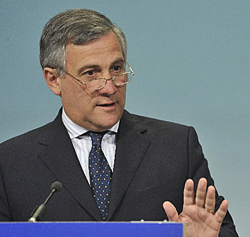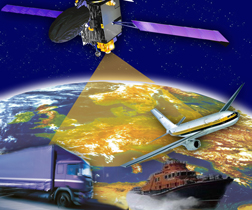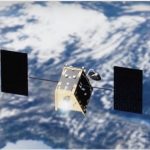 Antonio Tajani
Antonio TajaniAmid continuing debate over how to handle budgetary shortfalls in building a European GNSS, the European Space Agency (ESA) signed a €194 million ($270.5 million) contract on October 25 with SpaceOpal to provide space- and ground-based services to operate the Galileo constellation once it has been fully deployed.
Amid continuing debate over how to handle budgetary shortfalls in building a European GNSS, the European Space Agency (ESA) signed a €194 million ($270.5 million) contract on October 25 with SpaceOpal to provide space- and ground-based services to operate the Galileo constellation once it has been fully deployed.
On the occasion of the contract signing, European Commission Vice-President Antonio Tajani, Commissioner for Industry and Entrepreneurship said, “Galileo is becoming a reality. . . . We are fully committed to the roll-out of the system. Given the increased reliance of companies and citizens on satellite navigation, Galileo will play an important role in our daily lives.”
Three days later on October 28, the European Commission (EC) issued a communication on industrial policy that emphasized its commitment “to complete the Galileo constellation and put in place a new governance scheme.”
In between, European Union (EU), EC, ESA, and industry leaders debated the best ways to cut costs and raise additional funds for the Galileo program during discussions at a high-level conference in Brussels under the theme, “A New Space Policy for Europe.”
The contract awarded to SpaceOpal GmbH — the fourth of six planned “work packages” to support creation of an initial operational capability for Galileo — covers the industrial services needed to support ESA in operation of the satellites as well as the ground infrastructure. The two remaining procurement contracts, for the completion of the ground mission infrastructure and the ground control infrastructure, willbe awarded in early 2011, according to the EC.
SpaceOpal GmbH is a joint venture between Gesellschaft für Raumfahrtanwendungen (GfR,Space Applications Company) GmbH established by the German Aerospace Centre (DLR GfR), and Telespazio S.p.A. of Italy. Other members of the SpaceOpal team come from various ESA member states across Europe.
Galileo is now expected to achieve initial operational capability in 2014/15 and, under current plans, will provide three services at first: the Open Service (free), the Public Regulated Service (PRS) and a search-and rescue Service. Launches of the first of four in-orbit validation (IOV) satellites has been repeatedly delayed for technical and financial reasons and is now scheduled to occur in the second half of 2011.
Cost overruns in the IOV phases and higher than expected launcher costs led the EC late last year to acknowledge that the €3.4 billion allocated to the project would not be enough to complete the FOC system with a 27-satellite constellation.
Only enough funds for 14 satellites (plus the IOV spacecraft) were available. Consequently, full operational capability (FOC) has been pushed back to the 2016–18 timeframe and will require additional funds.
Backers of the program in the European Parliament said that new funds for Galileo need to be available in 2012 and 2013 and suggested that guarantees should be included in the 2011 EC budget, which is currently being negotiated.
EGNOS Service Back on Track
Meanwhile, problems with a monitoring station GPS receiver that delayed the start of the European Geostationary Navigation Overlay Service (EGNOS) safety of life operations appears to be nearing resolution.
Implementation of the EGNOS safety of life (SoL) service has been delayed due to a glitch with a GPS receiver in an EGNOS monitoring station.
The problem appeared on August 2, when the European Satellite Services Provider (ESSP) responsible for managing EGNOS operations initiated the procedure to transition towards the SoL service. A few minutes later, EGNOS transmitted “NOT MONITORED” messages for all GPS satellites and for the ionosphere correction data, rendering the service unusable.
It turned out that one type of GPS receiver used in the monitoring stations had performed an unnecessary check of the EGNOS GEO-ranging function. According to ESSP, the receiver performed a check on the value of bit 0 of the “Health and Status” parameter contained in Message Type 17 (MT17).
Because the GEO-ranging function is not activated for EGNOS, this bit 0 of MT17 is set to 1 (Off) in EGNOS transmissions. The receiver wrongly interpreted this status as a fault condition and reported this condition to the EGNOS processing facility. On August 6, ESSP reverted to the OS signal, that is, it transmitted the EGNOS signal with Message Type 0 (“Don’t Use for Safety Applications”).
ESSP says that all events observed at the system level have been traced back to a single cause at the level of the receiver in the monitoring station. A
correction has been developed and is now being tested.
ESSP expects that these remedial activities will be concluded in time for the SoL transition procedure to be completed by the end of the year. If all
goes well and the SoL service is then declared available, the first EGNOS approaches with vertical guidance (APV) could used by suitably equipped
aircraft beginning in January 2011 — although the EC may postpone an official announcement of the service until March.






